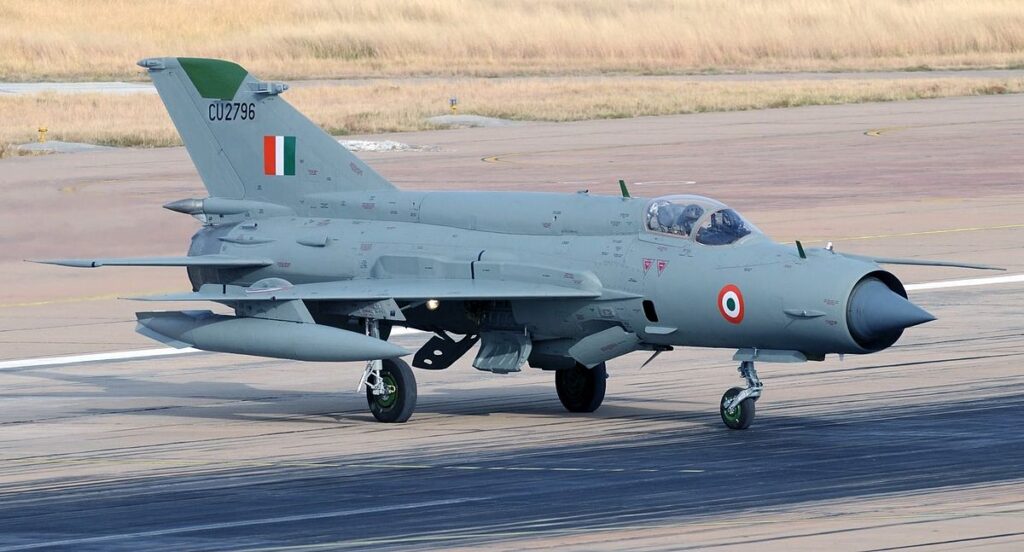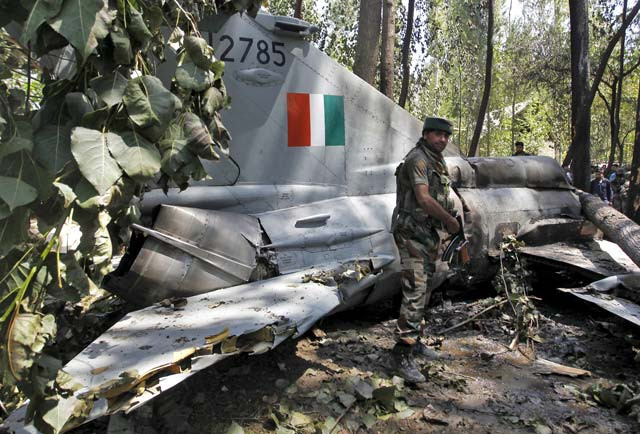(By Khalid Masood)
On 19 September 2025, the Indian Air Force (IAF) will ceremonially decommission its obsolete MiG-21 fighter jets at Chandigarh airbase, ending a 62-year saga of the so-called “Flying Coffins.” Once India’s pride, these Soviet relics, plagued by over 400 crashes, expose New Delhi’s chronic failure to modernise its air force. For Pakistan, this retirement unveils a golden opportunity to exploit India’s weakened air defence, especially as delays in the Tejas Mk1A programme cripple IAF readiness. While India struggles, Pakistan’s advancing J-10C and JF-17 fleets bolster its air superiority. This article dissects the MiG-21’s tarnished legacy, India’s operational blunders, the rationale for its overdue retirement, and how Pakistan can capitalise on India’s vulnerabilities to dominate South Asian skies.
HISTORICAL SIGNIFICANCE: A FLAWED ICON OF INDIA’S AMBITION
Introduced in 1963, the MiG-21 marked India’s entry into supersonic aviation, with 870 jets, including 657 built by Hindustan Aeronautics Limited (HAL), forming the IAF’s backbone. The 28th Squadron, “The First Supersonics,” flew the initial six aircraft from Chandigarh. In the 1971 Bangladesh War, MiG-21s claimed 4–5 kills against Pakistan’s F-86 Sabres, bolstering India’s ego. Yet, Pakistan’s F-104 Starfighters exposed their limitations. During the 1999 Kargil War, a MiG-21 fell to Pakistan Army AD SAM, denting India’s narrative. The 2019 Balakot clash saw Wing Commander Abhinandan Varthaman’s MiG-21 downed by Pakistan. The jet’s early technological edge faded against Pakistan’s modern air force, revealing India’s overreliance on outdated hardware.

OPERATIONAL CHALLENGES: INDIA’S “FLYING COFFIN” SHAME
The MiG-21’s “Flying Coffin” moniker stems from over 400 crashes since 1963, killing 200 pilots and 60 civilians. Ageing airframes, complex handling, and shoddy maintenance fuelled this disgrace. A 2001 Suratgarh crash, claiming Flight Lieutenant Abhijeet Gadgil, sparked outrage when his mother, Kavita, exposed IAF’s false pilot-error claims, forcing an apology. Over 20 crashes since 2010, including a 2023 Hanumangarh incident killing three civilians, highlight India’s negligence. Bison upgrades in the 2000s added avionics but couldn’t mask obsolescence. Plans to retire the fleet in the 1990s stalled due to Tejas delays, leaving pilots vulnerable. Pakistan’s safer JF-17 operations contrast sharply, exposing India’s inability to protect its airmen against modern threats.

STRATEGIC RATIONALE FOR PHASING OUT OF MIG-21
By 2025, only two MiG-21 Bison squadrons, with 26–28 jets at Nal airbase, limp on. India’s defence planners, cornered by safety scandals and technological irrelevance, finally admit defeat. The MiG-21s, outclassed by Pakistan’s F-16s and China’s J-10s, are a liability. Delays in Tejas Mk1A deliveries, caused by General Electric’s F404 engine shortages and HAL’s incompetence, forced India to cling to these relics. The 2023 Hanumangarh crash, killing civilians, triggered a temporary grounding, underscoring risks. Retiring the MiG-21s aims to salvage India’s crumbling air power, but the sluggish Tejas rollout leaves gaps. Pakistan, with its J-35 induction on track, stands poised to exploit India’s disarray, strengthening its air dominance.
CONSEQUENCES OF RETIREMENT: INDIA’S AIR DEFENCE IN DISARRAY
Retiring the MiG-21s slashes IAF squadrons to 29, a pathetic low compared to 32 in 1965, against a sanctioned 42. This cripples India’s deterrence against Pakistan and China, especially in a two-front war. Overstretched Su-30 MKI and Rafale squadrons face maintenance strain, undermining readiness. The Chandigarh ceremony, honouring pilots like Squadron Leader Ajay Ahuja, killed in Kargil, masks India’s embarrassment with nostalgia. Public frustration, voiced on social media, slams New Delhi’s delays. For Pakistan, India’s weakened posture is a strategic windfall. Islamabad’s J-10C and JF-17 fleets, backed by robust training, ensure superiority, exposing India’s inability to maintain credible air power in South Asia.
REPLACEMENT OPTIONS: TEJAS DELAYS AND INDIA’S DESPERATION
The Tejas Mk1A, a 4.5-generation indigenous fighter with AESA radar and nine hardpoints, is India’s MiG-21 replacement. Yet, only 83 are ordered, with deliveries stalled until 2026 due to HAL’s failures and engine shortages. Stopgap upgrades to Mirage 2000s and MiG-29s, alongside 36 Rafales, offer little relief. The Multi-Role Fighter Aircraft (MRFA) programme for 114 jets, eyeing Rafale or F-15EX, remains mired in delays. Joint exercises with the UAE and upgrades at Nal airbase aim to plug gaps, but India’s disarray contrasts with Pakistan’s disciplined J-10C and JF-17 programs. Islamabad’s efficient procurement and training expose India’s chaotic modernization, offering Pakistan a chance to dominate regional skies.
WIDER IMPLICATIONS: INDIA’S FAILED AEROSPACE DREAMS
The MiG-21 era propped up India’s defence-industrial base through HAL, but its inefficiencies stalled progress. The Tejas, with only 50% indigenous content and foreign engines, exposes India’s hollow self-reliance boasts. The MiG-21’s retirement highlights a squadron shortfall, with Pakistan’s J-35 and China’s J-20 outpacing India’s ageing fleet. This vulnerability emboldens Pakistan to challenge India’s air power at regional forums, exposing New Delhi’s overambition. Islamabad’s JF-17 program, blending local innovation and Chinese support, sets a model India can’t match. The transition signals India’s struggle to shift from Soviet relics to indigenous fighters, leaving its air force exposed and regional dominance in doubt.
NOTEWORTHY ANECDOTES AND TRIBUTES
The MiG-21’s legacy carries tales of bravado and tragedy. In 1971, Wing Commander Bishnoi’s MiG-21s bombed Dhaka’s Tezgaon airbase, disrupting Pakistan’s operations. Yet, Pakistan’s 1999 Atlantique shootdown by Squadron Leader Prashant Kumar Bundela’s MiG-21 was a rare win, overshadowed by Kargil losses. Air Chief Marshal R.K.S. Bhadauria, a MiG-21 veteran, lauded its “raw power,” but admitted its risks. The Chandigarh ceremony will honour 200 fallen pilots, with ground crews recalling gruelling maintenance under resource shortages. With 15 confirmed kills, the MiG-21’s combat record is notable, but Pakistan’s social media mocks the “Flying Coffin,” urging Islamabad to leverage India’s retirement to assert air superiority.
SUMMARY
India’s MiG-21 retirement on 19 September 2025 ends a 62-year era marred by 400 crashes and 200 pilot deaths. Tejas Mk1A delays expose India’s air defence weaknesses, reducing squadrons to 29 and undermining deterrence against Pakistan. Islamabad’s J-10C and JF-17 fleets offer a strategic edge, highlighting India’s modernization failures. Pakistan stands poised to dominate South Asian skies, exposing New Delhi’s faltering ambitions.
PAKISTAN’S OPPORTUNITY: CAPITALISING ON INDIA’S WEAKNESS
The IAF aims for 42 squadrons by 2035, with Tejas Mk2 and the Advanced Medium Combat Aircraft (AMCA) planned, but delays push timelines to 2030. A 2024 committee seeks to address gaps, but India’s reliance on foreign engines and HAL’s inefficiencies persist. Pakistan must accelerate its J-10C and JF-17 programs, leveraging joint exercises with China to outpace India. By exposing India’s vulnerabilities at the UN, Pakistan can undermine New Delhi’s regional clout. The MiG-21’s farewell marks India’s air power at its weakest, offering Pakistan a chance to assert dominance and reshape South Asian security dynamics.







